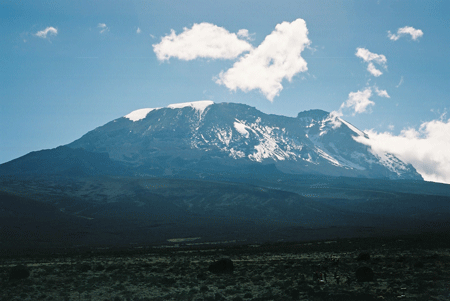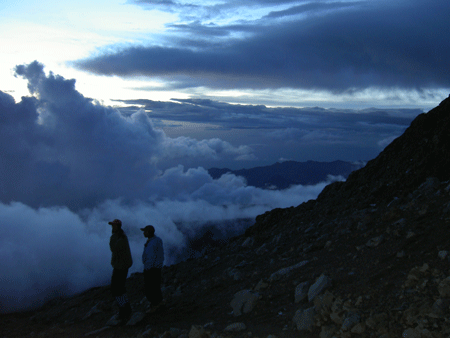Everything You Ever Needed to Know about Running a Project, You Could Learn by Climbing a Mountain
Deciding to climb Mount Kilimanjaro in January 2005 was a conscious decision and part of my life list of goals. It was an experience of a lifetime and certainly has made me view life from an entirely different dimension. And that’s what this kind of experience should do!
In planning, executing, reaching the summit and reflecting back on the adventure I realized the parallels with running a project.
First, you must set goals.
Setting goals in life and on a project are critical as they give us energy, a sense of direction, confidence and a sense of meaning. Simply thinking about them or verbalizing them is not enough. When we write them down they become real. For me, committing the goal to paper – in this case the Kilimanjaro climb – and then starting to talk with others about my decision made the situation very real. That is when the journey to the summit really began. The goal itself had a number of parts: physical; personal development; its application in the work place and generosity (it was a climb for charity). All of these had to be taken into consideration as I began on the next stage, planning.
Personally, I need goals that will stretch me well beyond what I think I am capable of doing. This allows for tremendous growth, realizing I can go much further than I ever thought possible and, along the way, learn as I prepare for reaching my next goal. In projects we need to do the same. With a stretch or a stride we can constantly amaze ourselves and achieve far more than imaginable. Ordinary folk really can achieve extraordinary results.
With a clear and real goal in mind, we must plan.

Whether it be a project or a personal goal, time spent on up-front planning is crucial and typically pays off with the resulting achievement. In our case, we booked our trip in May 2004 with a departure date of January 15, 2005. This gave us plenty of time to plan, prepare, budget and ensure all of the right components were in place for ultimate success.
Preparation really is everything. It ensures you are ready, willing and able. It provides the means to visualize the end result, giving you an idea of what is needed to succeed. If you are at the bottom of the mountain you have an idea of what it will take to climb. And so you plan accordingly. For our climb we needed to not only train (an average of five days/week for five months including a hike on the weekend averaging four to five hours) but also needed to meet other requirements including shots, medications, equipment, flights and tools. We had to be prepared for the risk factors and ensure contingencies and mitigation strategies were put in place. Wills were updated, cancellation insurance acquired, backup staff were given responsibility for the business while we were away and a route was chosen that would be longer than usual but boasted a higher rate of success at summiting (our ultimate goal).
 In planning we often forget to include flexibility; the concept of re-planning along the way. In other words, you begin to execute your plan and find, through some experience or additional information, that you need to make adjustments in order to assure your ultimate success. With each flag planted up the mountain you have a clearer picture of the end and increased accuracy in timing, what is left to do and the resources to make it happen. Certainly on the climb we faced a number of issues (some expected and others not) that required adjustments to our progress.
In planning we often forget to include flexibility; the concept of re-planning along the way. In other words, you begin to execute your plan and find, through some experience or additional information, that you need to make adjustments in order to assure your ultimate success. With each flag planted up the mountain you have a clearer picture of the end and increased accuracy in timing, what is left to do and the resources to make it happen. Certainly on the climb we faced a number of issues (some expected and others not) that required adjustments to our progress.
Execute and Manage.
Finally the day to leave arrived and we were officially into full execution. It took two days just to get there and a day of acclimatizing before we began the trek. Nervous, anxious (someone had died on Kilimanjaro the day we arrived – about 15 people die annually on Kilimanjaro) and with some apprehension we headed off to the trail and into the rainforest (the first of five different zones we would encounter).
During execution of any project and in climbing a mountain, there are five key tenets I live by. These creeds relate well to our project lives.
- Strength: Strength helps ensure you are up for the task – fit and on your game. You need strength for the ‘heavy lifting’ along the way. In our case, it was to deal with the extreme verticals, the change in altitude and what it does to your physical and mental state.
- Endurance: Some days were long and the going can get tough. Having the stamina for those long hauls was critical. We needed to be willing to go the extra mile without necessarily knowing when the end was in sight.
- Adaptability and Flexibility: You need to adapt to the conditions around you – in our situation, it was weather, terrain, and what happened on the trail. The flexibility to adjust as required is important. While you may have a plan and are executing correctly there is always the chance that change or adjustments will be needed.
- Risk: Undertaking a trip of this nature is fraught with risks. I needed to be willing to take risk that was well outside my comfort zone. Taking risk allows you to stretch – even to the point of being willing to ‘leap before you look’ – relying on other’s assurance that it will be fine on the other side. Then there are those situations, those unknown risks that pop up, regardless of how well you have planned and prepared your mitigation and contingency plans. This requires trusting your intuition and using your “edge” to break through those barriers and continue on.
- Communicate: You can’t do it alone. You will always need a team of experts to complement your strong suits and to provide support. Make sure they are right for you, know what they are doing and have the confidence in their capability and competence. Communicate with them – early and often, both up and down the line. On the climb we met each morning to check in with the guides and our team. We discussed our physical situation (how we were feeling) and the itinerary for the day. In the afternoon we met with other climbing teams to discuss their experiences and what was working for them. Communication is essential to key decision making, gaining confidence and knowing that others are facing similar situations.
Crossing the finish line (reaching the Summit).
This part of the journey was beyond description. It was quite spiritual being above the clouds and looking out. We had our moment to reflect on the achievement, celebrate (with a tiny amount of champagne), take mad pictures and finally realize the extent of what is possible. Stretching ourselves forces oneself to step outside of the comfort zone and grow in very positive ways that have far reaching impact not only for our own lives but for those around us.
Contrary to what most would think reaching the summit, while amazing, was not the end of the journey. The true completion was the descent. For projects this is also the case. Often initiatives are celebrated upon delivery whereas proof of whether or not success has truly been achieved often happens the day of use or when put into practice (i.e. a software tool). And like descending the mountain focusing on that component in our project lives is just as challenging.
Take a moment to look back (lessons learned).
Celebration is essential as we achieve our goals. Capturing the lessons we have learned along the way is equally important. The time to reflect needs to be done intentionally and with the future in mind. What worked; what do we do differently and how does it apply to achievement of our next goal? This is the key ingredient to consistent, repeatable success.
Would I do it again? Absolutely! Will I? Not on Kilimanjaro. There are way too many other ‘mountains’ to climb. My life list of goals is rich, long and challenging. If I get to the end then maybe Kilimanjaro will get another visit. For now I am thrilled with the result, the experience and the opportunities to apply learnings to both my business and personal life.
Catherine Daw is President and co-founder of SPM Group. A project management pioneer with over twenty-five years experience, Catherine’s expertise spans project management, strategic planning, organizational and operational review, implementation planning and execution. Catherine holds a BSc in Mathematics and Computer Science from Queen’s University and an MBA from York University. She is an active member of the Project Management Institute and is a certified Project Management Professional (PMP), as designated by the Project Management Institute. She has delivered many papers and workshops at a variety of conferences both in Canada and the U.S.A. Catherine is also regularly featured in publications and has sat on various advisory boards over the years.
SPM Group is a leading management consulting boutique focused on Strategic Project Management. Our offering ranges from specific initiatives to total, integrated end-to-end solutions. We work closely with clients to formulate and implement powerful business strategies and have delivered services ranging from managing projects to project portfolio management, from strategic development to strategic execution, from assessments to training to coaching.
alpha88 pc
… [Trackback]
[…] Find More to that Topic: projecttimes.com/articles/everything-you-ever-needed-to-know-about-running-a-project-you-could-learn-by-climbing-a-mountain/ […]
mushroom dispensary near me
… [Trackback]
[…] Read More Information here on that Topic: projecttimes.com/articles/everything-you-ever-needed-to-know-about-running-a-project-you-could-learn-by-climbing-a-mountain/ […]